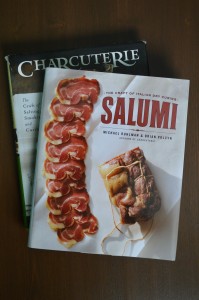 Michael Ruhlman is one of my favourite food writers, and a handful of his books have changed the way I think about food and cooking. I’m convinced that his book Ratio is the single most powerful and pragmatic cookbook ever written. He had a hand in The French Laundry Cookbook, one of the most influential cookbooks of the last twenty years. In his narrative Soul of a Chef he describes the discipline and dedication required to work in kitchens like that of The French Laundry. And of course there is the seminal book Charcuterie, a collaboration between Michael Ruhlman and Brian Polcyn that almost single-handedly started a cured meat revival in restaurants and home kitchens and backyards across North America.
Michael Ruhlman is one of my favourite food writers, and a handful of his books have changed the way I think about food and cooking. I’m convinced that his book Ratio is the single most powerful and pragmatic cookbook ever written. He had a hand in The French Laundry Cookbook, one of the most influential cookbooks of the last twenty years. In his narrative Soul of a Chef he describes the discipline and dedication required to work in kitchens like that of The French Laundry. And of course there is the seminal book Charcuterie, a collaboration between Michael Ruhlman and Brian Polcyn that almost single-handedly started a cured meat revival in restaurants and home kitchens and backyards across North America.
The book Salumi has been branded as a companion to Charcuterie. This is clear in the packaging: the book is from the same publisher, its the same size, and filled with the same instructive line drawings, though happily with the inclusion of some colour photographs, too. Salumi is broken into four sections. The first is theory and ingredients, then some basic recipes, followed by more complex recipes, and finally a chapter on cooking with salumi.
The chapter on dry-cured meats in Charcuterie is so thorough, both in theories and recipes, that I’ve been curious to see what new content would be introduced in Salumi ever since murmurs of the book first appeared on Ruhlman’s blog.
Thankfully there is some great original content in the theory and ingredients section. Most important I think are the detailed instructions on cutting whole pigs in both the Italian and American fashions. The logistics and economics of buying whole hogs was addressed in Charcuterie, so the most valuable info here is how to remove unique Italians cuts of pork like coppa, and how to clean a hing leg to make prosciutto.
While there is a lot of redundant information between this book and Charcuterie, there are some very interesting departures. For instance, in Salumi all of the whole muscle cuts – coppa, pancetta, guanciale, and so on – are cured with sea salt, without any sodium nitrate. (The only exception is if you plan to roll your pancetta, than nitrite is recommended.)
There is also an interesting section on fermenting salami with natural bacteria. While all the salami recipes in Salumi do call for Bacto-Ferm, there is a brief but informative discussion of how you could develop the same tanginess in your sausages without commercial products.
Since I just got my hands on the book last week, I haven’t had the chance to try any of the recipes. There is a good variety, and if they are as reliable as the ones in Charcuterie they will be fantastic starting points from which to develop unique recipes tailored to your individual tastes.
The final chapter on serving and cooking with salumi is the least interesting to me, but there are some good ideas for condiments.
All in all, while Salumi is nowhere near as densely informative as Charcuterie, I think it’s a great reference on this hallowed corner of the cured meat universe.